Tan S.T. Finite Mathematics for the Managerial, Life, and Social Sciences
Подождите немного. Документ загружается.

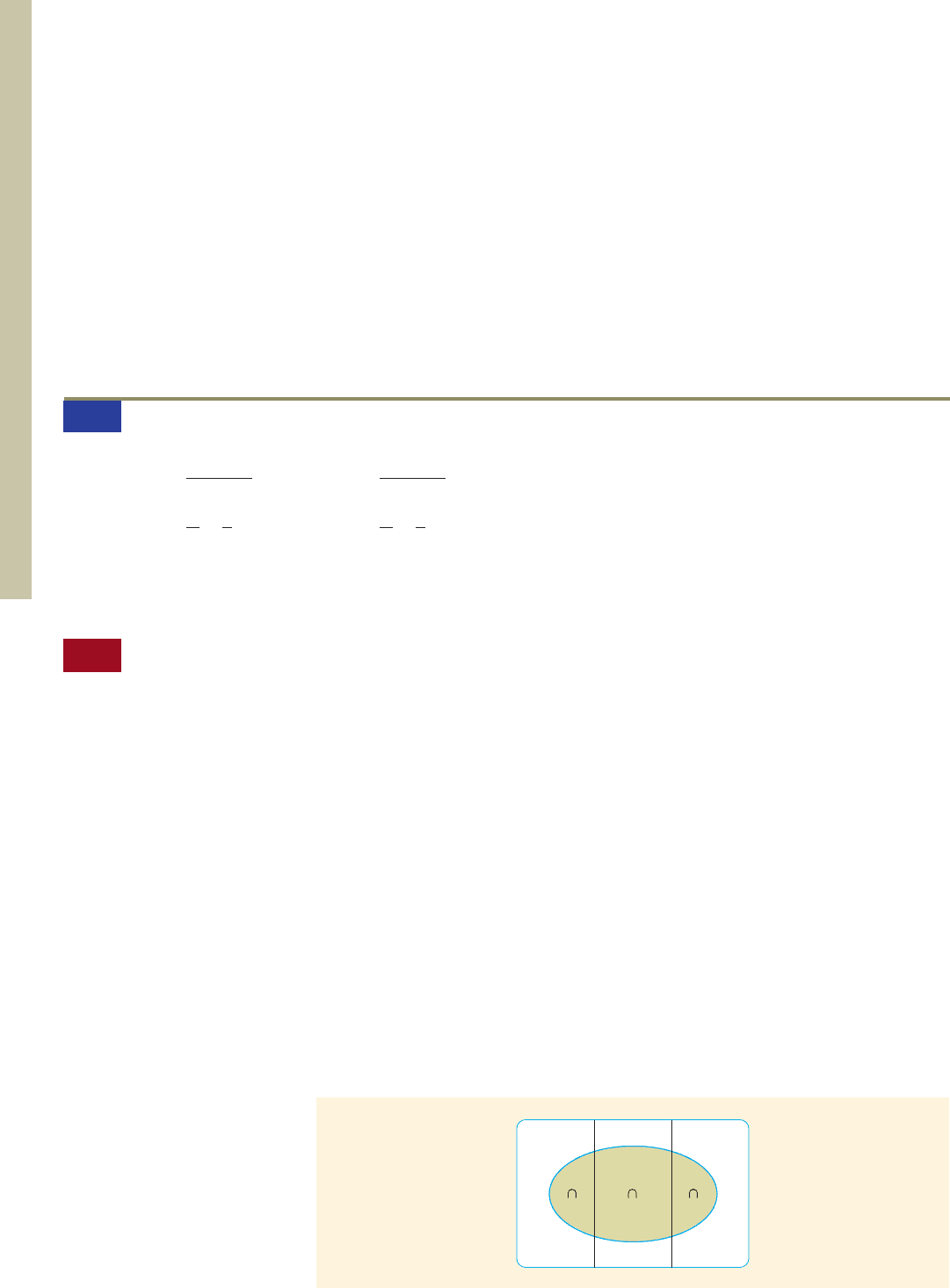
A Posteriori Probabilities
Suppose three machines, A, B, and C, produce similar engine components. Machine
A produces 45% of the total components, machine B produces 30%, and machine C,
25%. For the usual production schedule, 6% of the components produced by machine
A do not meet established specifications; for machine B and machine C, the corre-
sponding figures are 4% and 3%, respectively. One component is selected at random
from the total output and is found to be defective. What is the probability that the com-
ponent selected was produced by machine A?
The answer to this question is found by calculating the probability after the out-
comes of the experiment have been observed. Such probabilities are called a posteriori
probabilities as opposed to a priori probabilities—probabilities that give the likeli-
hood that an event will occur, the subject of the last several sections.
Returning to the example under consideration, we need to determine the a poste-
riori probability for the event that the component selected was produced by machine
A. Toward this end, let A, B, and C denote the events that a component is produced by
machine A, machine B, and machine C, respectively. We may represent this experi-
ment with a Venn diagram (Figure 21).
49. Suppose the probability that an event will occur in one trial
is p. Show that the probability that the event will occur at
least once in n independent trials is 1 (1 p)
n
.
50. Let E and F be mutually exclusive events and suppose
P(F ) 0. Find P(E 兩 F ) and interpret your result.
51. Let E and F be events such that F 傺 E. Find P(E 兩 F ) and
interpret your result.
52. Suppose that A and B are mutually exclusive events and
that P(A 傼 B) 0. What is P(A 兩 A 傼 B)?
53. Let E and F be independent events; show that E and F
c
are
independent.
In Exercises 54–57, determine whether the statement is
true or false. If it is true, explain why it is true. If it is
false, give an example to show why it is false.
54. If A and B are mutually exclusive and P(B) 0, then
P(A 兩 B) 0.
55. If A is an event of an experiment, then P(A 兩 A
c
) 0.
56. If A and B are events of an experiment, then
P(A 傽 B) P(A 兩 B)
P(B) P(B 兩 A)
P(A)
57. If A and B are independent events with P(A) 0 and
P(B) 0, then A 傽 B .
402
7 PROBABILITY
7.5 Solutions to Self-Check Exercises
1. a. b.
2. Let A, B, and C denote the events that a respondent who was
married between the ages of 20 and 22, between the ages of
.3
.4
3
4
.3
.8
3
8
P1B 0A 2
P1A 艚 B 2
P1A2
P1A 0B 2
P1A 艚 B 2
P1B2
23 and 27, and at age 28 or older (respectively) said that his
or her marriage was “less than very happy.” Then the prob-
ability of each of these events occurring is P(A) .297,
P(B) .269, and P(C) .451. So the probability that all
three of the respondents said that his or her marriage was
“less than very happy” is
P1A2
#
P1B2
#
P1C2 1.29721.26921.4512⬇ .036
7.6 Bayes’ Theorem
SAB
ABCDDD
D
C
FIGURE 21
D is the event that a defective compo-
nent is produced by machine A, machine
B, or machine C.
87533_07_ch7_p353-416 1/30/08 10:05 AM Page 402
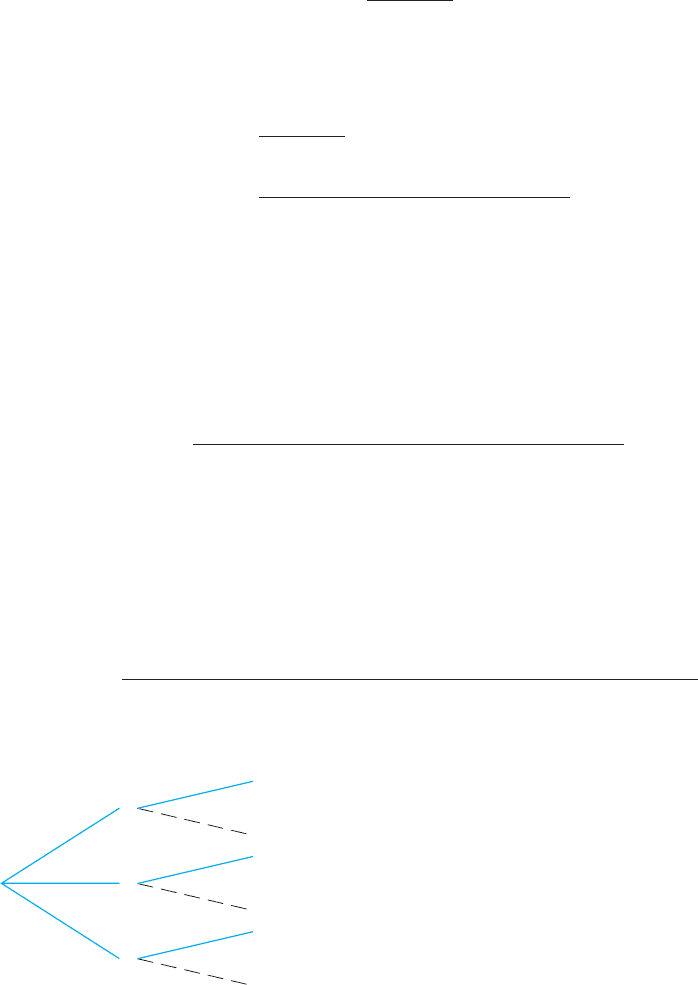
7.6 BAYES’ THEOREM 403
The three mutually exclusive events A, B, and C form a partition of the sample
space S; that is, aside from being mutually exclusive, their union is precisely S. The
event D that a component is defective is the shaded area. Again referring to Fig-
ure 21, we see that
1. The event D may be expressed as
2. The event that a component is defective and is produced by machine A is given by
A 傽 D.
Thus, the a posteriori probability that a defective component selected was produced
by machine A is given by
Upon dividing both the numerator and the denominator by P(S) and observing that the
events A 傽 D, B 傽 D, and C 傽 D are mutually exclusive, we obtain
(7)
Next, using the product rule, we may express
P(A 傽 D) P(A)
P(D 兩 A)
P(B 傽 D) P(B)
P(D 兩 B)
P(C 傽 D) P(C)
P(D 兩 C)
so Equation (7) may be expressed in the form
(8)
which is a special case of a result known as Bayes’ theorem.
Observe that the expression on the right of Equation (8) involves the probabilities
P(A), P(B), and P(C ) as well as the conditional probabilities P(D 兩 A), P(D 兩 B), and
P(D 兩 C). In fact, by displaying these probabilities on a tree diagram, we obtain Fig-
ure 22. We may compute the required probability by substituting the relevant quanti-
ties into (8), or we may make use of the following device:
P1A 0D2
Product of probabilities along the branch through A terminating at D
Sum of products of the probabilities along each branch terminating at D
P1A 0D2
P1A2
#
P1D 0A2
P1A2
#
P1D 0A2 P1B2
#
P1D 0B2 P1C2
#
P1D 0C2
P1A 艚 D2
P1A 艚 D2 P1B 艚 D2 P1C 艚 D 2
P1A 0D2
P1A 艚 D2
P1D2
P1A 0D2
P1A 艚 D2
P1D2
D 1A 艚 D 2傼 1B 艚 D 2傼 1C 艚 D 2
D
D
c
A
B
C
P(B) = .30
P(
A
) = .45
P
(
C
) = .25
P
(D
|
A
) = .06
P
(D
|
B
) = .04
P(D
|
C
) = .03
D
D
c
c
D
D
FIGURE 22
A tree diagram displaying the probabili-
ties that a defective component is pro-
duced by machine A, machine B, or
machine C
87533_07_ch7_p353-416 1/30/08 10:05 AM Page 403

In either case, we obtain
Before looking at any further examples, let’s state the general form of Bayes’
theorem.
APPLIED EXAMPLE 1
Quality Control The panels for the Pulsar
32-inch widescreen LCD HDTVs are manufactured in three locations and
then shipped to the main plant of Vista Vision for final assembly. Plants A, B,
and C supply 50%, 30%, and 20%, respectively, of the panels used by Vista
Vision. The quality-control department of the company has determined that 1%
of the panels produced by plant A are defective, whereas 2% of the panels pro-
duced by plants B and C are defective. If a Pulsar 32-inch HDTV is selected at
random and the panel is found to be defective, what is the probability that the
panel was manufactured in plant C? (Compare with Example 6, page 394.)
Solution
Let A, B, and C denote the events that the set chosen has a panel man-
ufactured in plant A, plant B, and plant C, respectively. Also, let D denote the
event that a set has a defective panel. Using the given information, we may draw
the tree diagram shown in Figure 23. Next, using Formula (9), we find that the
required a posteriori probability is given by
APPLIED EXAMPLE 2
Income Distributions A study was conducted
in a large metropolitan area to determine the annual incomes of married
couples in which the husbands were the sole providers and of those in which the
husbands and wives were both employed. Table 9 gives the results of this study.
⬇ .27
1.2021.02 2
1.5021.01 2 1.3021.022 1.2021.022
P1C 0D 2
P 1C2
#
P 1D 0C2
P 1A2
#
P 1D 0A2 P 1B2
#
P 1D 0B2 P 1C2
#
P 1D 0C2
Bayes’ Theorem
Let A
1
, A
2
, . . . , A
n
be a partition of a sample space S, and let E be an event
of the experiment such that P(E) 0 and P(A
i
) 0 for 1 i n. Then the
a posteriori probability P(A
i
兩 E ) (1 i n) is given by
(9)
⬇ .58
P1A 0D 2
1.4521.06 2
1.4521.06 2 1.3021.042 1.2521.032
404 7 PROBABILITY
D
D
c
A
B
C
P(B) = .3
P
(
A
) = .5
P
(
C
) = .2
P
(D
|
A
) = .01
P
(D
|
B
) = .02
P
(
D
|
C
) = .02
D
D
c
c
D
D
FIGURE 23
P(C 兩 D)
Product of probabilities of
branches to
D
through
C
Sum of product of probabilities
of branches leading to
D
P 1A
i
0E 2
P 1A
i
2
#
P 1E 0A
i
2
P 1A
1
2
#
P 1E 0A
1
2 P 1A
2
2
#
P 1E 0A
2
2
p
P 1A
n
2
#
P 1E 0A
n
2
TABLE 9
Annual Family Income Group
Income, $ Married Couples, % with Both Spouses Working, %
150,000 and over 4 65
100,000–149,999 10 73
75,000–99,999 21 68
50,000–74,999 24 63
30,000–49,999 30 43
Under 30,000 11 28
87533_07_ch7_p353-416 1/30/08 10:05 AM Page 404
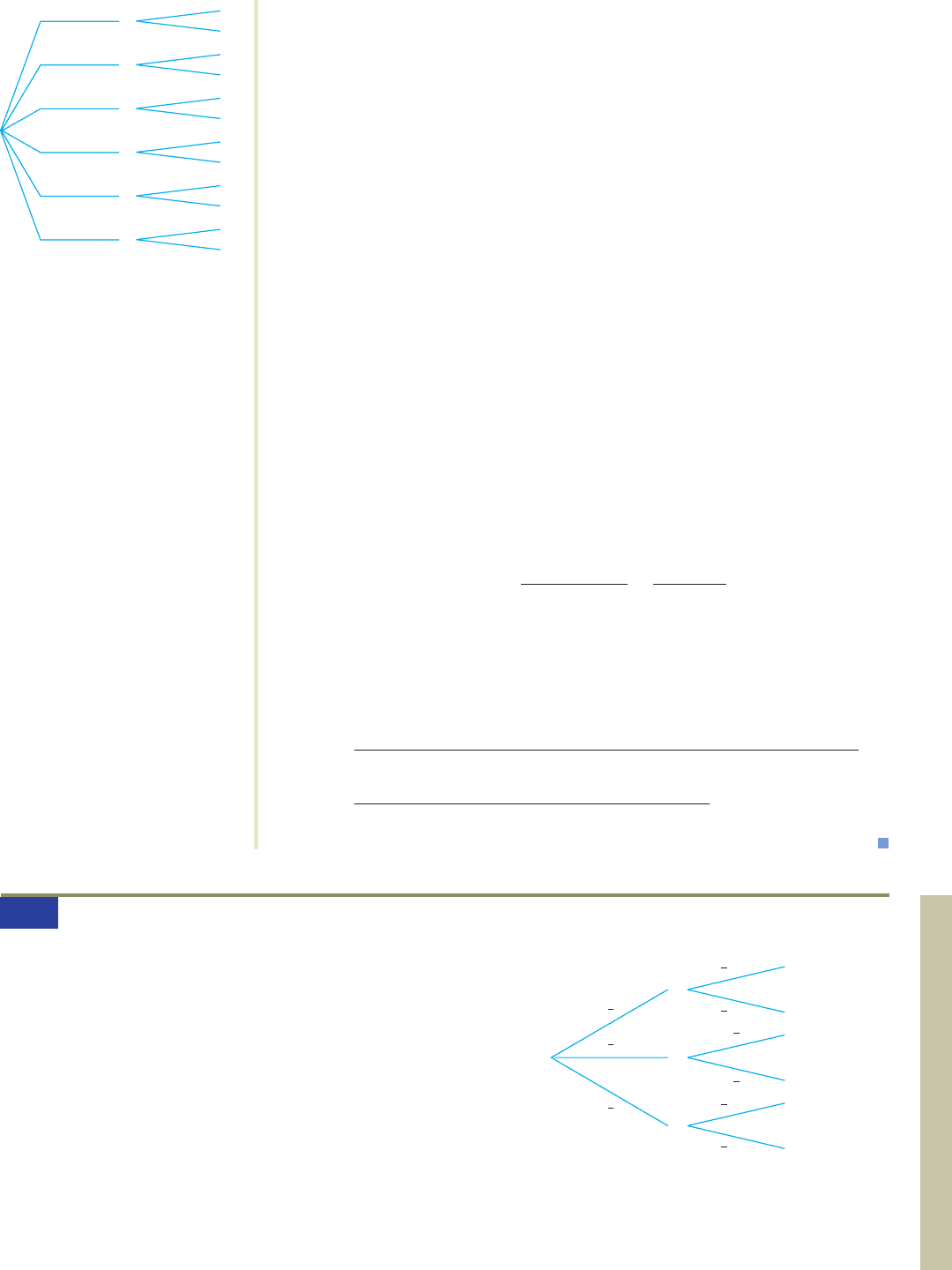
a. What is the probability that a couple selected at random from this area has two
incomes?
b. If a randomly chosen couple has two incomes, what is the probability that the
annual income of this couple is $150,000 or more?
c. If a randomly chosen couple has two incomes, what is the probability that the
annual income of this couple is greater than $49,999?
Solution
Let A denote the event that the annual income of the couple is
$150,000 or more; let B denote the event that the annual income is between
$100,000 and $149,999; let C denote the event that the annual income is
between $75,000 and $99,999; and so on. Finally, let T denote the event that
both spouses work. The probabilities of the occurrence of these events are dis-
played in Figure 24.
a. The probability that a couple selected at random from this group has two
incomes is given by
b. Using the results of part (a) and Bayes’ theorem, we find that the probability
that a randomly chosen couple has an annual income of $150,000 or more,
given that both spouses are working, is
c. The probability that a randomly chosen couple has an annual income greater
than $49,999, given that both spouses are working, is
⬇ .711
1.0421.65 2 1.121.732 1.2121.682 1.2421.63 2
.5528
P1A2
#
P1T 0A2 P1B2
#
P1T 0B2 P1C2
#
P1T 0C2 P1D2
#
P1T 0D2
P1T2
P1A 0 T 2 P1B 0T 2 P1C 0T 2 P1D 0T 2
⬇ .047
P1A 0T 2
P1A2
#
P1T 0A2
P1T2
1.0421.65 2
.5528
.5528
1.3021.432 1.1121.282
1.0421.652 1.1021.732 1.2121.682 1.2421.632
P1D 2
#
P1T 0D2 P1E2
#
P1T 0E2 P1F2
#
P1T 0F2
P1T 2 P1A 2
#
P1T 0A2 P1B2
#
P1T 0B2 P1C2
#
P1T 0C2
7.6 BAYES’ THEOREM 405
T
T
c
A
B
C
D
E
F
P(A) = .04
.65
.35
T
T
c
.73
.27
T
T
c
.68
.32
T
T
c
T
T
c
.43
.57
T
T
c
.63
.37
.28
.72
P(B) = .10
P(C) = .21
P(D) = .24
P(E) = .30
P(F) = .11
FIGURE 24
7.6 Self-Check Exercises
1. The accompanying tree diagram represents a two-stage
experiment. Use the diagram to find P(B 兩 D).
D
D
c
A
B
C
D
D
c
D
D
c
1
2
1
4
3
4
1
2
1
2
1
3
2
3
1
4
1
4
87533_07_ch7_p353-416 1/30/08 10:05 AM Page 405
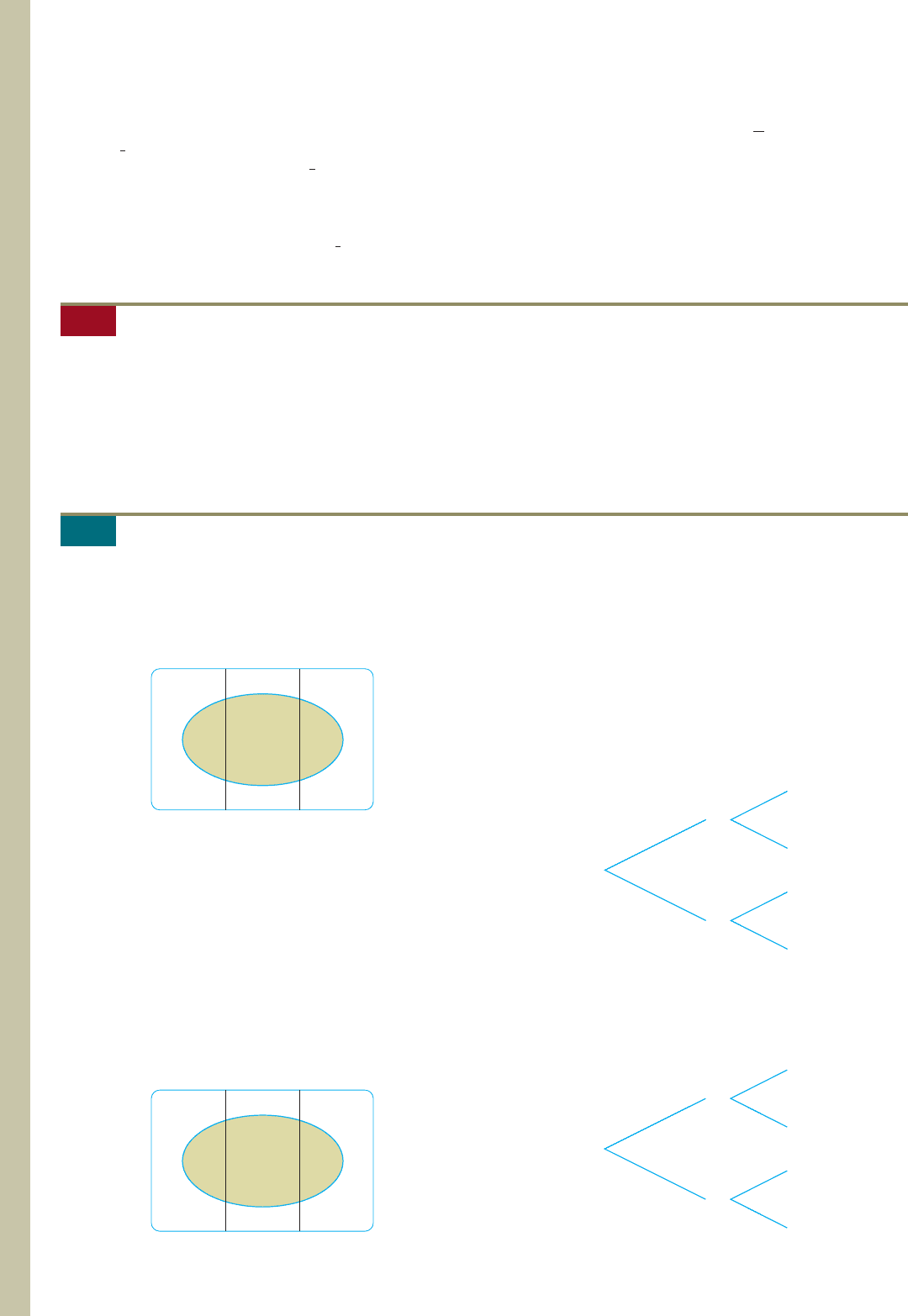
2. In a recent presidential election, it was estimated that the
probability that the Republican candidate would be elected
was and therefore the probability that the Democratic
3
5
cratic candidate were successful, then the probability that
the research would continue was . Research was termi-
nated shortly after the successful presidential candidate
took office. What is the probability that the Republican
candidate won that election?
Solutions to Self-Check Exercises 7.6 can be found on
page 411.
3
10
406 7 PROBABILITY
candidate would be elected was (the two Independent
candidates were given little chance of being elected). It
was also estimated that if the Republican candidate were
elected, then the probability that research for a new
manned bomber would continue was . But if the Demo-
4
5
2
5
7.6 Exercises
7.6 Concept Questions
1. What are a priori probabilities and a posteriori probabili-
ties? Give an example of each.
2. Suppose the events A, B, and C form the partition of a sam-
ple space S, and suppose E is an event of an experiment
such that P(E) 0. Use Bayes’ theorem to write the for-
mula for the a posteriori probability . (Assume
P(A), P(B), P(C) 0.)
3. Refer to Question 2. If E is the event that a product was pro-
duced in factory A, factory B, or factory C and P(E) 0,
what does represent?
P1A 0E 2
P1A 0E 2
In Exercises 1–3, refer to the accompanying Venn dia-
gram. An experiment in which the three mutually exclu-
sive events A, B, and C form a partition of the uniform
sample space S is depicted in the diagram.
1. Using the information given in the Venn diagram, draw a
tree diagram illustrating the probabilities of the events A,
B, C, and D.
2. Find: a. P(D) b.
3. Find: a. P(D
c
) b.
In Exercises 4–6, refer to the accompanying Venn dia-
gram. An experiment in which the three mutually exclu-
sive events A, B, and C form a partition of the uniform
sample space S is depicted in the diagram.
S
AB
D
C
20 20
25
25 20 15
P1B 0D
c
2
P1A 0D 2
S
AB
D
C
10 20
20 25 10
15
4. Using the information given in the Venn diagram, draw a
tree diagram illustrating the probabilities of the events A,
B, C, and D.
5. Find: a. P(D) b.
6. Find: a. P(D
c
) b.
7. The accompanying tree diagram represents a two-stage ex-
periment. Use the diagram to find
a. b.
c.
8. The accompanying tree diagram represents a two-stage ex-
periment. Use the diagram to find
a. b.
c.
D
D
c
A
B
.35
.65
.7
.3
D
D
c
.6
.4
P1A 0D 2
P1B2
#
P1D 0B 2P1A2
#
P1D 0A 2
D
D
c
A
B
.4
.6
.2
.8
D
D
c
.25
.75
P1A 0D 2
P1B2
#
P1D 0B 2P1A2
#
P1D 0A 2
P1B 0D
c
2
P1B 0D 2
87533_07_ch7_p353-416 1/30/08 10:05 AM Page 406
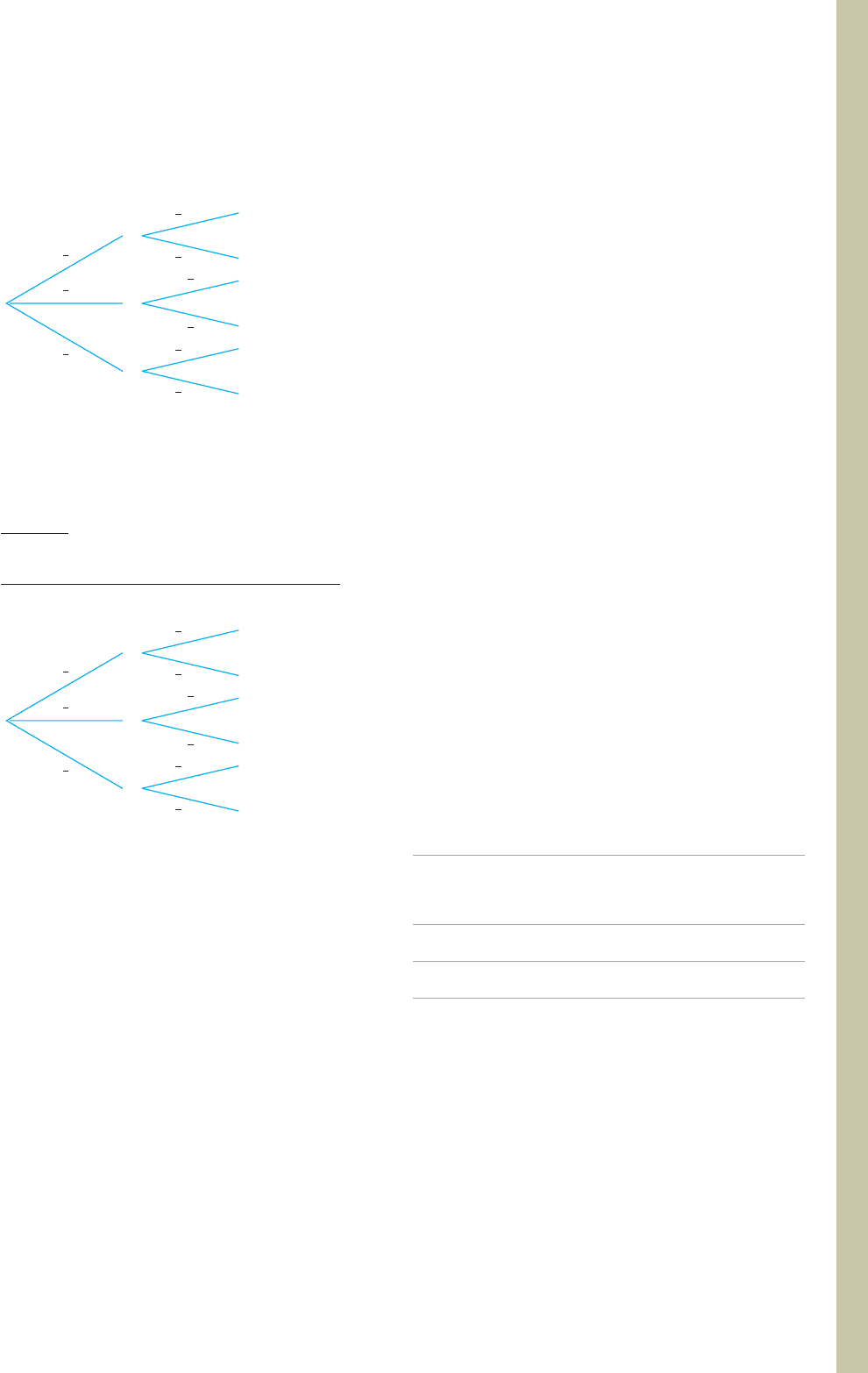
7.6 BAYES’ THEOREM 407
9. The accompanying tree diagram represents a two-stage ex-
periment. Use the diagram to find
a. b.
c. d.
10. The accompanying tree diagram represents a two-stage ex-
periment. Use this diagram to find
a. P(A 傽 D) b. P(B 傽 D) c. P(C 傽 D) d. P(D)
e. Verify:
In Exercises 11–14, refer to the following experiment:
Two cards are drawn in succession without replacement
from a standard deck of 52 cards.
11. What is the probability that the first card is a heart given
that the second card is a heart?
12. What is the probability that the first card is a heart given
that the second card is a diamond?
13. What is the probability that the first card is a jack given
that the second card is an ace?
14. What is the probability that the first card is a face card
given that the second card is an ace?
In Exercises 15–18, refer to the following experiment:
Urn A contains four white and six black balls. Urn B con-
tains three white and five black balls. A ball is drawn
from urn A and then transferred to urn B. A ball is then
drawn from urn B.
15. Represent the probabilities associated with this two-stage
experiment in the form of a tree diagram.
16. What is the probability that the transferred ball was white
given that the second ball drawn was white?
D
D
c
A
B
C
D
D
c
D
D
c
2
5
1
2
1
2
1
3
2
3
3
4
1
4
1
5
2
5
P1A2
#
P1D 0A 2
P1A2
#
P1D 0A 2 P1B2
#
P1D 0B 2 P1C2
#
P1D 0C 2
P1A 0D 2
P1A 艚 D 2
P1D2
D
D
c
A
B
C
D
D
c
D
D
c
1
2
1
2
1
2
1
4
3
4
1
3
2
3
1
3
1
6
P1A 0D 2P1C2
#
P1D 0C 2
P1B2
#
P1D 0B 2P1A2
#
P1D 0A 2
17. What is the probability that the transferred ball was black
given that the second ball drawn was white?
18. What is the probability that the transferred ball was black
given that the second ball drawn was black?
19. P
OLITICS
The 1992 U.S. Senate was composed of
57 Democrats and 43 Republicans. Of the Democrats,
38 served in the military, whereas 28 of the Republicans
had seen military service. If a senator selected at random
had served in the military, what is the probability that he
or she was Republican?
20. R
ETIREMENT
N
EEDS
In a survey of 2000 adults 50 yr and
older of whom 60% were retired and 40% were pre-
retired, the following question was asked: Do you expect
your income needs to vary from year to year in retire-
ment? Of those who were retired, 33% answered no, and
67% answered yes. Of those who were pre-retired, 28%
answered no, and 72% answered yes. If a respondent in
the survey was selected at random and had answered yes
to the question, what is the probability that he or she was
retired?
Source: Sun Life Financial
21. An experiment consists of randomly selecting one of three
coins, tossing it, and observing the outcome—heads or
tails. The first coin is a two-headed coin, the second is a
biased coin such that P(H) .75, and the third is a fair
coin.
a. What is the probability that the coin that is tossed will
show heads?
b. If the coin selected shows heads, what is the probability
that this coin is the fair coin?
22. S
EAT
-B
ELT
C
OMPLIANCE
Data compiled by the Highway
Patrol Department regarding the use of seat belts by drivers
in a certain area after the passage of a compulsory seat-belt
law are shown in the accompanying table.
Percent of
Percent Group Stopped
of Drivers for Moving
Drivers in Group Violation
Group I
(using seat belts) 64 .2
Group II
(not using seat belts) 36 .5
If a driver in that area is stopped for a moving violation,
what is the probability that he or she
a. Will have a seat belt on?
b. Will not have a seat belt on?
23. B
LOOD
T
ESTS
If a certain disease is present, then a blood
test will reveal it 95% of the time. But the test will also
indicate the presence of the disease 2% of the time when in
fact the person tested is free of that disease; that is, the test
gives a false positive 2% of the time. If 0.3% of the general
population actually has the disease, what is the probability
that a person chosen at random from the population has the
disease given that he or she tested positive?
87533_07_ch7_p353-416 1/30/08 10:05 AM Page 407
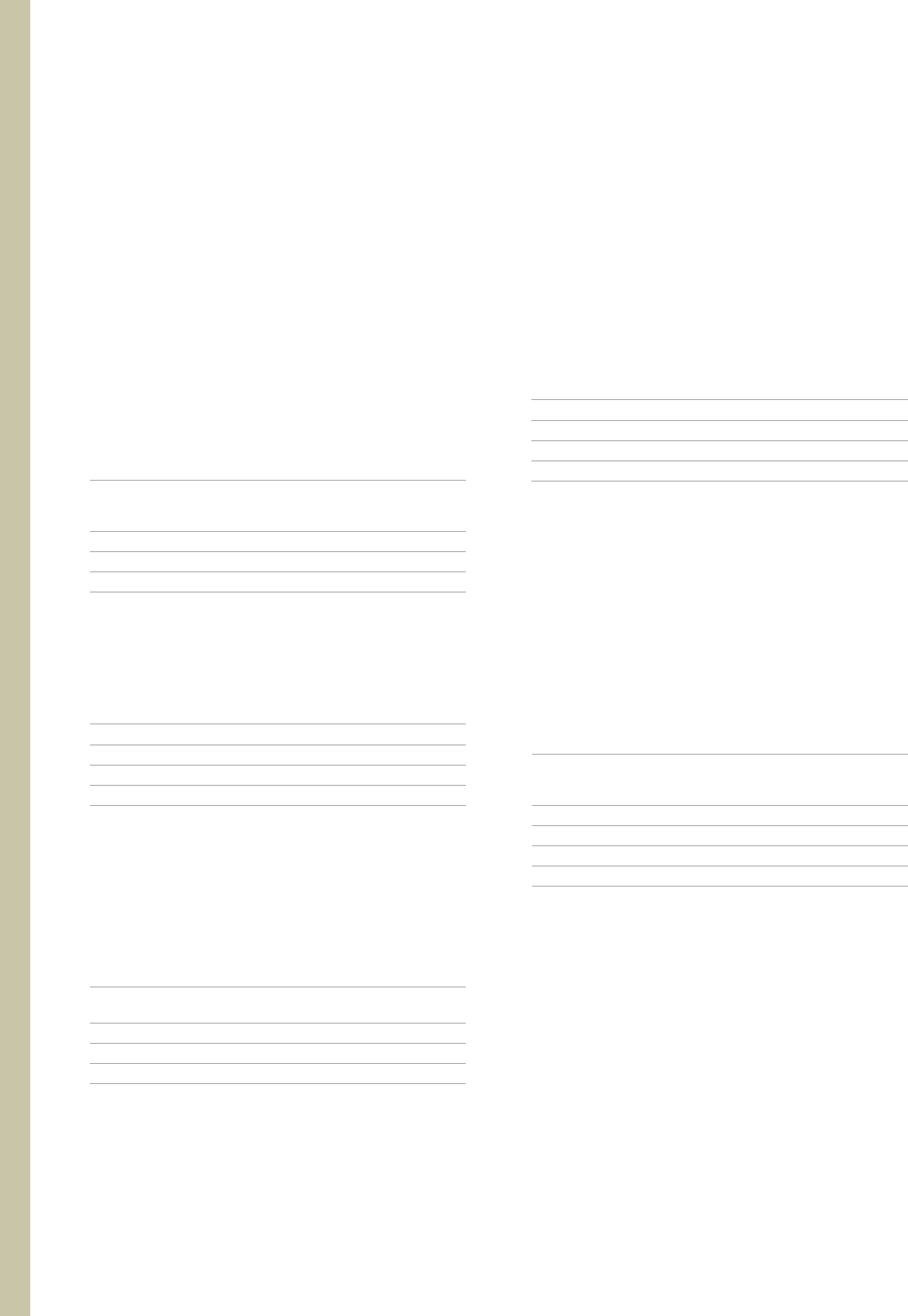
24. O
PINION
P
OLLS
In a survey to determine the opinions of
Americans on health insurers, 400 baby boomers and 600
pre-boomers were asked this question: Do you believe that
insurers are very responsible for high health costs? Of the
baby boomers, 212 answered in the affirmative, whereas
198 of the pre-boomers answered in the affirmative. If
a respondent chosen at random from those surveyed
answered the question in the affirmative, what is the prob-
ability that he or she is a baby boomer? A pre-boomer?
Source: GfK Roper Consulting
25. Q
UALITY
C
ONTROL
A halogen desk lamp produced by
Luminar was found to be defective. The company has three
factories where the lamps are manufactured. The percent-
age of the total number of halogen desk lamps produced by
each factory and the probability that a lamp manufactured
by that factory is defective are shown in the accompanying
table. What is the probability that the defective lamp was
manufactured in factory III?
Probability of
Percent of Defective
Factory Total Production Component
I 35 .015
II 35 .01
III 30 .02
26. O
PINION
P
OLLS
A survey involving 400 likely Democratic
voters and 300 likely Republican voters asked the ques-
tion: Do you support or oppose legislation that would
require registration of all handguns? The following results
were obtained:
Answer Democrats, % Republicans, %
Support 77 59
Oppose 14 31
Don’t know/refused 9 10
If a randomly chosen respondent in the survey answered
“oppose,” what is the probability that he or she is a likely
Democratic voter?
27. A
GE
D
ISTRIBUTION OF
R
ENTERS
A study conducted by the
Metro Housing Agency in a midwestern city revealed the
following information concerning the age distribution of
renters within the city.
Group
Age Adult Population, % Who Are Renters, %
21–44 51 58
45–64 31 45
65 and over 18 60
a. What is the probability that an adult selected at random
from this population is a renter?
b. If a renter is selected at random, what is the probability
that he or she is in the 21–44 age bracket?
c. If a renter is selected at random, what is the probability
that he or she is 45 yr of age or older?
28. P
RODUCT
R
ELIABILITY
The estimated probability that a
brand-A, a brand-B, and a brand-C plasma TV will last at
least 30,000 hr is .90, .85, and .80, respectively. Of the
4500 plasma TVs that Ace TV sold in a certain year, 1000
were brand A, 1500 were brand B, and 2000 were brand C.
If a plasma TV set sold by Ace TV that year is selected at
random and is still working after 30,000 hr of use
a. What is the probability that it was a brand-A TV?
b. What is the probability that it was not a brand-A TV?
29. O
PINION
P
OLLS
A survey involving 400 likely Democratic
voters and 300 likely Republican voters asked the ques-
tion: Do you support or oppose legislation that would
require trigger locks on guns, to prevent misuse by chil-
dren? The following results were obtained:
Answer Democrats, % Republicans, %
Support 88 71
Oppose 7 20
Don’t know/refused 5 9
If a randomly chosen respondent in the survey answered
“support,” what is the probability that he or she is a likely
Republican voter?
30. Q
UALITY
C
ONTROL
Jansen Electronics has four machines
that produce an identical component for use in its DVD
players. The proportion of the components produced by
each machine and the probability of that component being
defective are shown in the accompanying table. What is the
probability that a component selected at random
a. Is defective?
b. Was produced by machine I, given that it is defective?
c. Was produced by machine II, given that it is defective?
Proportion of Probability of
Components Defective
Machine Produced Component
I .15 .04
II .30 .02
III .35 .02
IV .20 .03
31. C
RIME
R
ATES
Data compiled by the Department of Justice
on the number of people arrested in a certain year for seri-
ous crimes (murder, forcible rape, robbery, and so on)
revealed that 89% were male and 11% were female. Of the
males, 30% were under 18, whereas 27% of the females ar-
rested were under 18.
a. What is the probability that a person arrested for a seri-
ous crime in that year was under 18?
b. If a person arrested for a serious crime in that year is
known to be under 18, what is the probability that the
person is female?
Source: Department of Justice
32. R
ELIABILITY OF
M
EDICAL
T
ESTS
A medical test has been de-
signed to detect the presence of a certain disease. Among
those who have the disease, the probability that the disease
will be detected by the test is .95. However, the probabil-
408
7 PROBABILITY
87533_07_ch7_p353-416 1/30/08 10:05 AM Page 408
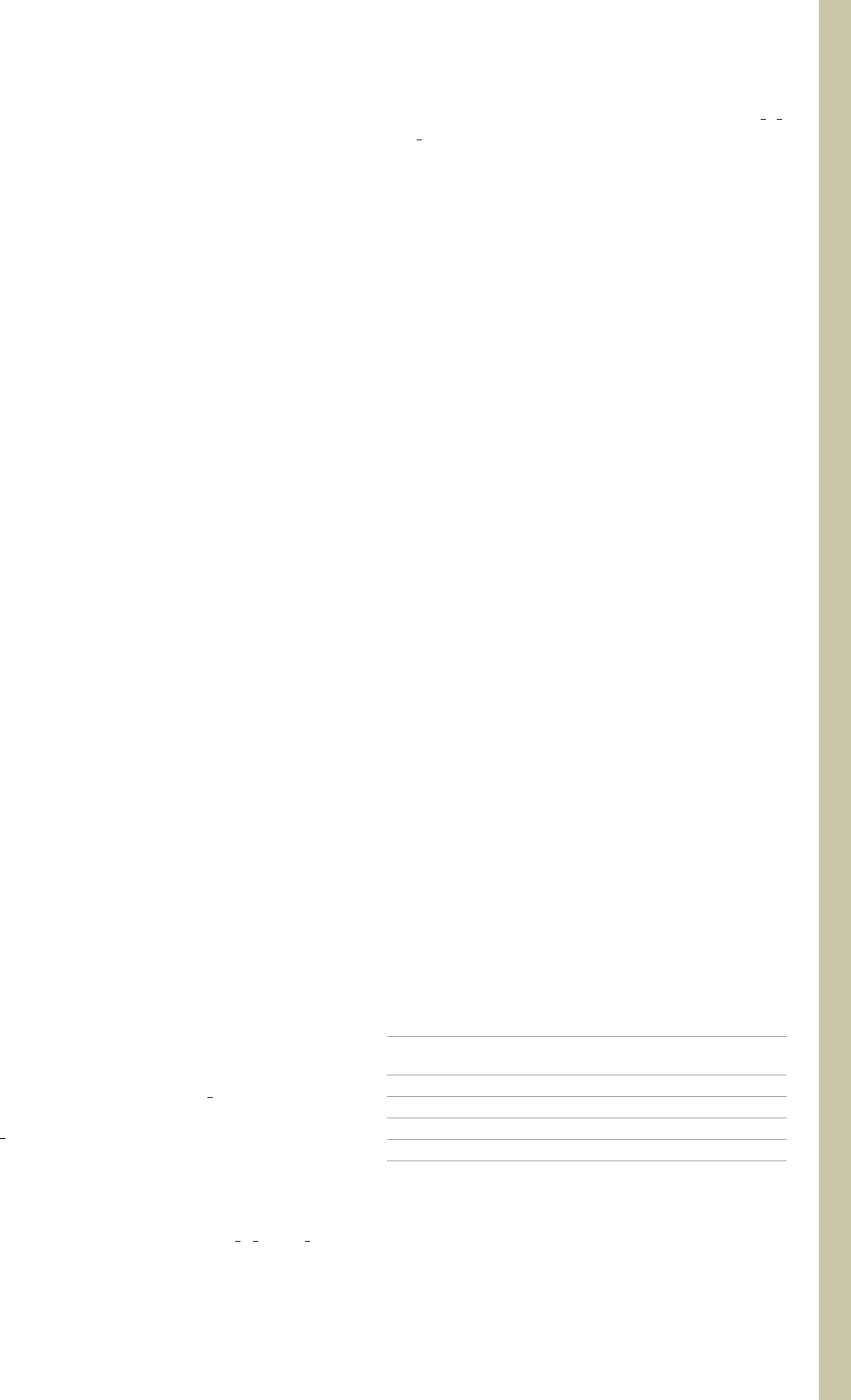
ity that the test will erroneously indicate the presence of the
disease in those who do not actually have it is .04. It is esti-
mated that 4% of the population who take this test have the
disease.
a. If the test administered to an individual is positive, what
is the probability that the person actually has the dis-
ease?
b. If an individual takes the test twice and both times the
test is positive, what is the probability that the person
actually has the disease? (Assume that the tests are
independent.)
33. R
ELIABILITY OF
M
EDICAL
T
ESTS
Refer to Exercise 32. Sup-
pose 20% of the people who were referred to a clinic for
the test did in fact have the disease. If the test administered
to an individual from this group is positive, what is the
probability that the person actually has the disease?
34. G
ENDER
G
AP
A study of the faculty at U.S. medical schools
in 2006 revealed that 32% of the faculty were women and
68% were men. Of the female faculty, 31% were full/
associate professors, 47% were assistant professors, and
22% were instructors. Of the male faculty, 51% were
full/associate professors, 37% were assistant professors, and
12% were instructors. If a faculty member at a U.S. medical
school selected at random holds the rank of full/associate
professor, what is the probability that she is female?
Source: Association of American Medical Colleges
35. B
EVERAGE
R
ESEARCH
In a study of the scientific research on
soft drinks, juices, and milk, 50 studies were fully spon-
sored by the food industry, and 30 studies were conducted
with no corporate ties. Of those that were fully sponsored
by the food industry, 14% of the participants found the
products unfavorable, 23% were neutral, and 63% found
the products favorable. Of those that had no industry fund-
ing, 38% found the products unfavorable, 15% were neu-
tral, and 47% found the products favorable.
a. What is the probability that a participant selected at ran-
dom found the products favorable?
b. If a participant selected at random found the product
favorable, what is the probability that he or she belongs
to a group that participated in a corporate-sponsored
study?
Source: Children’s Hospital, Boston
36. S
ELECTION OF
S
UPREME
C
OURT
J
UDGES
In a past presidential
election, it was estimated that the probability that the Re-
publican candidate would be elected was , and therefore
the probability that the Democratic candidate would be
elected was (the two Independent candidates were given
no chance of being elected). It was also estimated that if
the Republican candidate were elected, the probability that
a conservative, moderate, or liberal judge would be
appointed to the Supreme Court (one retirement was
expected during the presidential term) was , , and ,
respectively. If the Democratic candidate were elected, the
probabilities that a conservative, moderate, or liberal judge
1
6
1
3
1
2
2
5
3
5
would be appointed to the Supreme Court would be , ,
and , respectively. A conservative judge was appointed to
the Supreme Court during the presidential term. What is
the probability that the Democratic candidate was elected?
37. P
ERSONNEL
S
ELECTION
Applicants for temporary office
work at Carter Temporary Help Agency who have suc-
cessfully completed a typing test are then placed in suitable
positions by Nancy Dwyer and Darla Newberg. Employers
who hire temporary help through the agency return a card
indicating satisfaction or dissatisfaction with the work per-
formance of those hired. From past experience it is known
that 80% of the employees placed by Nancy are rated as
satisfactory, and 70% of those placed by Darla are rated as
satisfactory. Darla places 55% of the temporary office help
at the agency and Nancy the remaining 45%. If a Carter
office worker is rated unsatisfactory, what is the probabil-
ity that he or she was placed by Darla?
38. M
EDICAL
R
ESEARCH
Based on data obtained from the
National Institute of Dental Research, it has been deter-
mined that 42% of 12-yr-olds have never had a cavity, 34%
of 13-yr-olds have never had a cavity, and 28% of 14-yr-
olds have never had a cavity. Suppose a child is selected at
random from a group of 24 junior high school students that
includes six 12-yr-olds, eight 13-yr-olds, and ten 14-yr-
olds. If this child does not have a cavity, what is the prob-
ability that this child is 14 yrs old?
Source: National Institute of Dental Research
39. V
OTING
P
ATTERNS
In a recent senatorial election, 50% of
the voters in a certain district were registered as Demo-
crats, 35% were registered as Republicans, and 15% were
registered as Independents. The incumbent Democratic
senator was reelected over her Republican and Indepen-
dent opponents. Exit polls indicated that she gained 75% of
the Democratic vote, 25% of the Republican vote, and 30%
of the Independent vote. Assuming that the exit poll is
accurate, what is the probability that a vote for the incum-
bent was cast by a registered Republican?
40. A
UTO
-A
CCIDENT
R
ATES
An insurance company has com-
piled the accompanying data relating the age of drivers and
the accident rate (the probability of being involved in an
accident during a 1-yr period) for drivers within that group:
Percent of Accident
Age Group Insured Drivers Rate, %
Under 25 16 5.5
25–44 40 2.5
45–64 30 2
65 and over 14 4
What is the probability that an insured driver selected at
random
a. Will be involved in an accident during a particular 1-yr
period?
b. Who is involved in an accident is under 25?
1
2
3
8
1
8
7.6 BAYES’ THEOREM 409
87533_07_ch7_p353-416 1/30/08 10:05 AM Page 409

41. P
ERSONAL
H
ABITS
There were 80 male guests at a party.
The number of men in each of four age categories is given
in the following table. The table also gives the probability
that a man in the respective age category will keep his
paper money in order of denomination.
Age Men Keep Paper Money in Order, %
21–34 25 9
35–44 30 61
45–54 15 80
55 and over 10 80
A man’s wallet was retrieved and the paper money in it was
kept in order of denomination. What is the probability that
the wallet belonged to a male guest between the ages of 35
and 44?
42. V
OTER
T
URNOUT BY
I
NCOME
Voter turnout drops steadily as
income level declines. The following table gives the per-
cent of eligible voters in a certain city, categorized by
income, who responded with “did not vote” in the 2000
presidential election. The table also gives the number of
eligible voters in the city, categorized by income.
Income Percent Who
(percentile) “Did Not Vote” Eligible Voters
0–16 52 4,000
17–33 31 11,000
34–67 30 17,500
68–95 14 12,500
96–100 12 5,000
If an eligible voter from this city who had voted in the elec-
tion is selected at random, what is the probability that this
person had an income in the 17–33 percentile?
Source: The National Election Studies
43. T
HE
S
OCIAL
L
ADDER
The following table summarizes the
results of a poll conducted with 1154 adults.
Respondents
Respondents
Annual within That
Who Call Themselves
Household Income Middle
Income, $ Range, % Rich, % Class, % Poor, %
Less than 15,000 11.2 0 24 76
15,000–29,999 18.6 3 60 37
30,000–49,999 24.5 0 86 14
50,000–74,999 21.9 2 90 8
75,000 and higher 23.8 5 91 4
a. What is the probability that a respondent chosen at ran-
dom calls himself or herself middle class?
b. If a randomly chosen respondent calls himself or herself
middle class, what is the probability that the annual
household income of that individual is between $30,000
and $49,999, inclusive?
c. If a randomly chosen respondent calls himself or herself
middle class, what is the probability that the individ-
ual’s income is either less than or equal to $29,999 or
greater than or equal to $50,000?
Source: New York Times/CBS News; Wall Street Journal Almanac
44. O
BESITY IN
C
HILDREN
Researchers weighed 1976 3-yr-olds
from low-income families in 20 U.S. cities. Each child is
classified by race (white, black, or Hispanic) and by weight
(normal weight, overweight, or obese). The results are tab-
ulated as follows:
Weight, %
Race Children Normal Weight Overweight Obese
White 406 68 18 14
Black 1081 68 15 17
Hispanic 489 56 20 24
If a participant in the research is selected at random and is
found to be obese, what is the probability that the 3-yr-old
is white? Hispanic?
Source: American Journal of Public Health
45. C
OLLEGE
M
AJORS
The Office of Admissions and Records
of a large western university released the accompanying
information concerning the contemplated majors of its fresh-
man class:
Freshmen
Choosing
Major This Major, % Females, % Males, %
Business 24 38 62
Humanities 8 60 40
Education 8 66 34
Social science 7 58 42
Natural sciences 9 52 48
Other 44 48 52
What is the probability that
a. A student selected at random from the freshman class is
a female?
b. A business student selected at random from the fresh-
man class is a male?
c. A female student selected at random from the freshman
class is majoring in business?
46. V
OTER
T
URNOUT BY
P
ROFESSION
The following table gives
the percent of eligible voters grouped according to profes-
sion who responded with “voted” in the 2000 presidential
election. The table also gives the percent of people in a sur-
vey categorized by their profession.
Percent Percent in
Profession Who Voted Each Profession
Professionals 84 12
White collar 73 24
Blue collar 66 32
Unskilled 57 10
Farmers 68 8
Housewives 66 14
410 7 PROBABILITY
87533_07_ch7_p353-416 1/30/08 10:05 AM Page 410
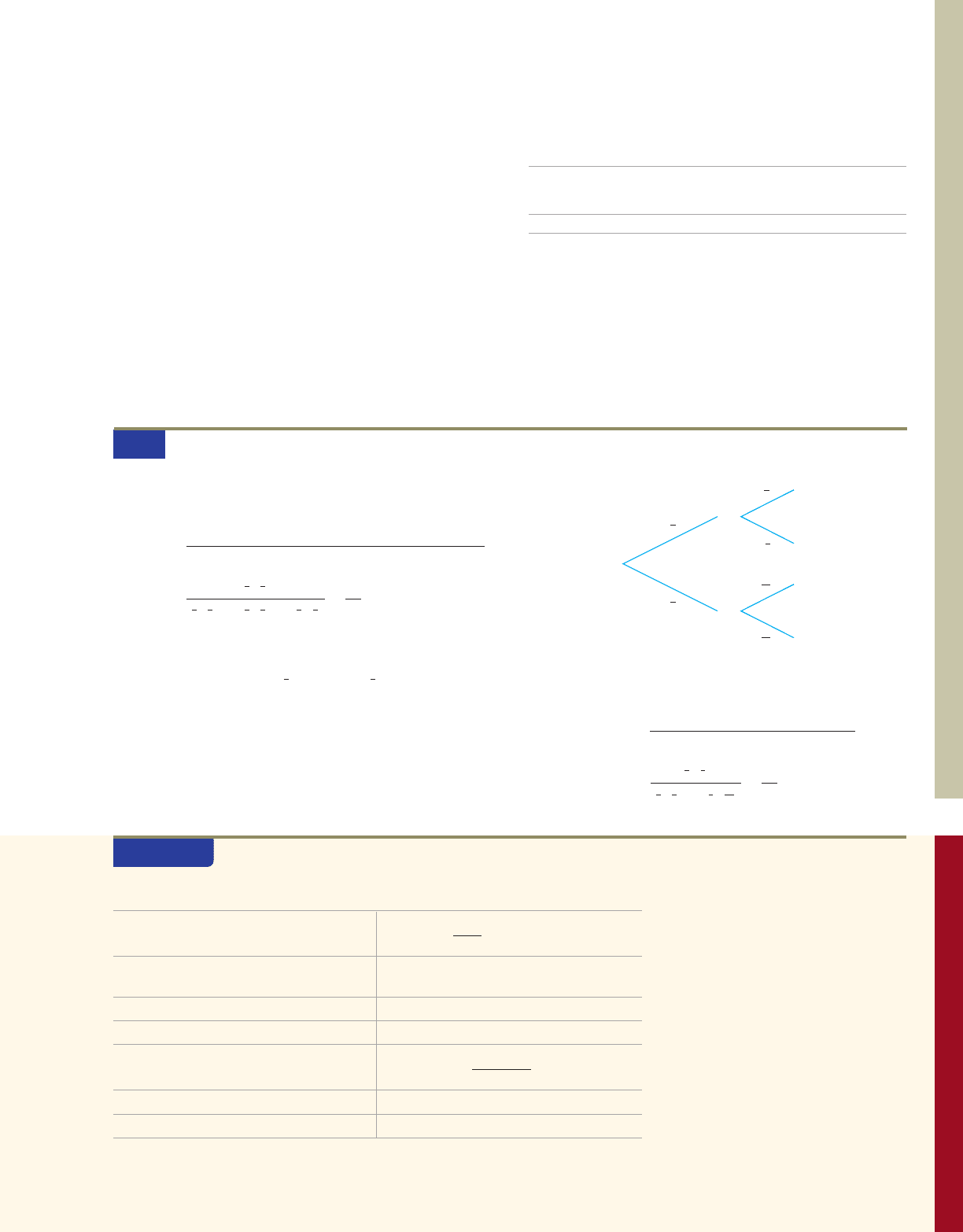
If an eligible voter who participated in the survey and
voted in the election is selected at random, what is the
probability that this person is a housewife?
Source: The National Election Studies
47. M
EDICAL
D
IAGNOSES
A study was conducted among a cer-
tain group of union members whose health insurance poli-
cies required second opinions prior to surgery. Of those
members whose doctors advised them to have surgery,
20% were informed by a second doctor that no surgery was
needed. Of these, 70% took the second doctor’s opinion
and did not go through with the surgery. Of the members
who were advised to have surgery by both doctors, 95%
went through with the surgery. What is the probability that
a union member who had surgery was advised to do so by
a second doctor?
48. S
MOKING AND
E
DUCATION
According to the Centers for Dis-
ease Control and Prevention, the percentage of adults 25 yr
and older who smoke, by educational level, is as follows:
High Under-
Educational No GED school Some graduate Graduate
Level diploma diploma graduate college level degree
Respondents, % 26 43 25 23 10.7 7
In a group of 140 people, there were 8 with no diploma, 14
with GED diplomas, 40 high school graduates, 24 with
some college, 42 with an undergraduate degree, and 12
with a graduate degree. (Assume that these categories are
mutually exclusive.) If a person selected at random from
this group was a smoker, what is the probability that he or
she is a person with a graduate degree?
Source: Centers for Disease Control and Preventions
SUMMARY OF PRINCIPAL FORMULAS AND TERMS 411
7.6 Solutions to Self-Check Exercises
1. Using the probabilities given in the tree diagram and
Bayes’ theorem, we have
2. Let R and D, respectively, denote the event that the Repub-
lican and the Democratic candidate won the presidential
election. Then, and . Also, let C denote
the event that research for the new manned bomber contin-
ued. These data may be exhibited as in the accompanying
tree diagram:
P1D2
2
5
P1R2
3
5
1
1
2
21
1
2
2
1
1
4
21
1
3
2 1
1
2
21
1
2
2 1
1
4
21
1
4
2
12
19
P1B | D2
P1B2
#
P1D | B2
P1A2
#
P1D | A2 P1B2
#
P1D | B2 P1C2
#
P1D | C2
Using Bayes’ theorem, we find that the probability that the
Republican candidate had won the election is given by
1
3
5
21
1
5
2
1
3
5
21
1
5
2 1
2
5
21
7
10
2
3
10
P1R 0C
c
2
P1R2
#
P1C
c
0R 2
P1R2
#
P1C
c
0R 2 P1D2
#
P1C
c
0D 2
C
C
c
R
D
C
C
c
3
5
2
5
4
5
1
5
3
10
7
10
Summary of Principal Formulas and Terms
CHAPTER 7
FORMULAS
1. Probability of an event in a uniform
sample space
2. Probability of the union of two P(E 傼 F) P(E) P(F)
mutually exclusive events
3. Addition rule P(E 傼 F) P(E) P(F ) P(E 傽 F)
4. Rule of complements P(E
c
) 1 P(E)
5. Conditional probability , P(A) ⬆ 0
6. Product rule
7. Test for independence P(A 傽 B) P(A)
P(B)
P1A 艚 B 2 P1A2
#
P1B 0A2
P1B 0A 2
P1A 艚 B 2
P1A2
P1E2
n1E2
n1S2
87533_07_ch7_p353-416 1/30/08 10:05 AM Page 411
